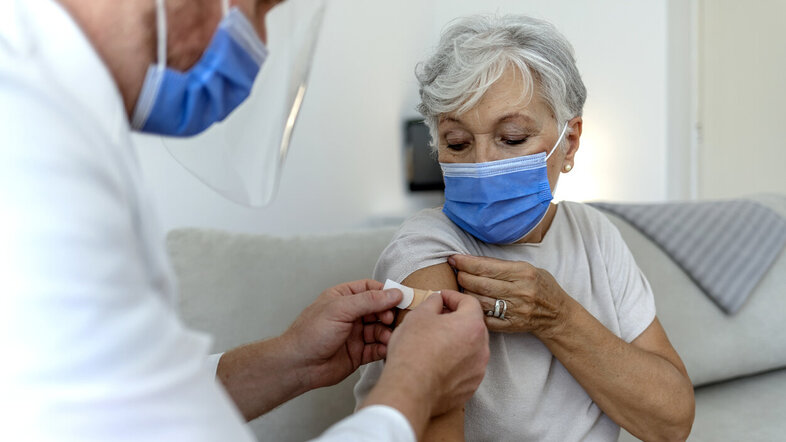Vaccine patch without pinprick
Christoph Rademacher is an expert in molecular drug targeting. In his laboratory at the Faculty of Life Sciences at the University of Vienna, he is working on new therapies for targeted active substance transport, i.e. the path of a drug to its destination in the body. Currently, his research revolves around the hot topic of ‘platform technology’. "The same basic structures can be used for several vaccines; only the pathogen-specific component is being changed," explains Rademacher.
Vaccination ‘without detours’
Rademacher already conducted research on vaccines during his time at the Max Planck Institute of Colloids and Interfaces in Potsdam, where he developed the Langerhans Cell Delivery System (LC-TDS process for short), a pioneering method for vaccine development. The technology makes it possible to target specific cells of the immune system to fight various infections and diseases.
"Until now, many vaccines have been administered intramuscularly. However, there are few immune cells in our muscles that could do anything with the vaccine. So the vaccine has to take a 'detour': out of the muscle and into the lymph nodes to activate the immune system there," explains Rademacher. The new LC-TDS method makes this process more efficient: Thanks to special molecules, the vaccine is targeted to particularly suitable receptors in the top layer of the skin, which then ensure the production of antibodies. Our skin has a dense network of so-called Langerhans cells, which react optimally to such a vaccine – and gave the process its name.
Vaccine patch: a vaccination that goes on the skin
In the future, this technology should make it possible to administer a vaccine via a patch that is applied to the skin. And there is great general interest in this – "around ten percent of the Austrian population suffer from a needlestick phobia," says the active substance researcher. Another positive effect is that many local side effects of vaccinations are caused by ‘wrong’ punctures, and these could also be circumvented by a vaccine patch.
"However, we see the greatest advantage of the vaccine patch in the fact that people can vaccinate themselves or that medical care personnel can administer the vaccination. It is also no longer necessary to ensure an uninterrupted cold chain. If we just think of the beginning of the COVID vaccination, the cold chain and the short shelf life of the vaccines were huge challenges. With patches, we might be able to overcome these problems and distribute vaccines all over the world – theoretically even in an envelope by mail," says the drug targeting expert.
With patches, we might be able to overcome these problems and distribute vaccines all over the world – theoretically even in an envelope by mail.Christoph Rademacher
From the idea to the product – this is how new therapies are created
Dreams of the future or within reach – how far away are we from the vaccine patch for home use? The development of new therapies and their approval is very complex, explains Christoph Rademacher. For the vaccine patch, he and his dedicated team at the University of Vienna first experimented with cell cultures under the microscope to investigate whether immune cells are actually stimulated and whether toxicity might occur.
In the next step, the vaccine was tested ex vivo on a skin model, "for this we had at our disposal remnants from breast plastic surgery or tummy tucks ." We could therefore test on an intact piece of skin whether the cells reacted as they did in the isolated state. The immune response was then tested in living model organisms. "We are currently in the preclinical phase. But it may take up to ten years before the product is actually ready for the market," predicts the biochemist.
An opportunity with Novartis
To drive further innovative research in its lab, pharmaceutical company Novartis awarded funding to Christoph Rademacher for his research proposal as part of the prestigious NIBR Global Scholars Program. "Although I cannot provide you with any details about the cooperation (yet), we are dealing with exciting questions related to drug targeting," reveals Rademacher. The relevance can be demonstrated using cancer therapy as an example. The high-dose active substances of chemotherapy should only attack tumour cells and not healthy cells. Together with colleagues from Novartis, the experts from the University of Vienna are researching a method that will enable them to better target and address specific cells more easily since the method should be applicable to different cell types.
In early 2021, Christoph Rademacher founded Cutanos GmbH, a now successful Viennese biotech start-up, to further develop LC-TDS technology in the field of viral vaccines and autoimmune diseases.
When science and industry put their heads together...
...a more fruitful exchange emerges. This is clearly illustrated by the LC-TDS method. Rademacher and his research colleagues have developed the basic technology. However, it is difficult for a university or a research institution to bring it to market – "and that is not their job. So we founded Cutanos ourselves to be more agile and have access to other resources", Rademacher says, "For this reason, the collaboration with Novartis is fantastic, because the 'applied perspective' comes into play. We have regular meetings with colleagues from Novartis during which we share important questions and give each other input. We also notice that the 'project management thinking' in industry has a slightly different drive that advances developments – together we can make advances." (hm)
- Department of Pharmaceutical Sciences of the Faculty of Life Sciences
- Website of Christoph Rademacher
- Website of Cutanos GmbH
- CV of Christoph Rademacher
- Current publication in Frontiers in Immunology: Specific Protein Antigen Delivery to Human Langerhans Cells in Intact Skin
- Knowledge exchange website of the University of Vienna
